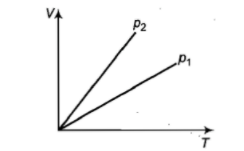In the adjacent V-T diagram what is the relation between ?


1.
2.
3.
4. cannot be predicated


1.
Which one of the following graph is correct at constant pressure?
| 1. |  |
2. |  |
| 3. |  |
4. |  |
The root-mean-square velocity of the molecules in a sample of helium is of that of the molecules in a sample of hydrogen. If the temperature of the hydrogen gas is 0C, that of the helium sample is about:
1. 0C
2. 5.6C
3. 273C
4. 100C
The kinetic energy of one gram molecule of a gas at standard temperature and pressure is: (R = 8.31 J/mol-K)
1. 0.56
2.
3.
4.
Gases exert pressure on the walls of containing vessel because the gas molecules:
1. Possess momentum
2. collide with each other
3. have finite volume
4. obey gas laws
The equation of state for 5 g of oxygen at a pressure P and temperature T, when occupying a volume V, will be: (where R is the constant)
1. PV = 5RT
2. PV =
3. PV =
4. PV =
The equation is known as:
1. Perfect gas equation
2. Joule Thomson's equation
3. Vander Waal's equation
4. Maxwell's equation
The temperature of an ideal gas is increased from to . The r.m.s. speed of its molecules becomes-
1. twice
2. half
3. four times
4. one fourth
An ideal gas is filled in a vessel, then
1. If it is placed inside a moving train, its temperature increases
2. Its centre of mass moves randomly
3. Its temperature remains constant in a moving car
4. None of these
The molecular weight of two gases is \(M_1\) and \(M_2.\) At any temperature, the ratio of root mean square velocities \(v_1\) and \(v_2\) will be:
1. \(\sqrt{\frac{M_1}{M_2}}\)
2. \(\sqrt{\frac{M_2}{M_1}}\)
3. \(\sqrt{\frac{M_1+M_2}{M_1-M_2}}\)
4. \(\sqrt{\frac{M_1-M_2}{M_1+M_2}}\)






